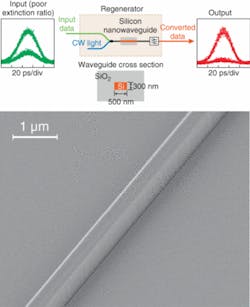Optical communications systems find their limits as signals degrade along the network, but a new approach may provide a way to simply and cheaply maintain signal fidelity. While solutions exist to amplify optical signals as they decay, the process adds noise. At a critical signal-to-noise ratio, the signal must be completely regenerated—including reshaping, retiming, and reamplifying the signal in so-called 3R regeneration.
Existing solutions for the “repeaters” that accomplish this depend on conversion of the optical signal to an electronic one, electronic signal processing, and then conversion back to an optical signal. It is a complex approach that creates heat and is prone to errors, so a recent research push is to find a means to regenerate the signal in an all-optical setup.
Silicon, as the darling of the electronics industry, would be well-placed as the material of choice for such regeneration. However, it has only just started to prove itself as a high-performance optical material. Now, Reza Salem and colleagues at Cornell University (Ithaca, New York) have demonstrated an all-optical, low-power regeneration scheme on a silicon chip.
The group’s trick is to exploit the high optical nonlinearity of silicon nanowaveguides. The geometry of the waveguides confines the light in space and boosts their nonlinearity by 200,000 times relative to standard fibers. The researchers used that characteristic to its advantage last year, demonstrating that nanostructured silicon can be used as a medium for pulse reshaping in a self-phase-modulation approach, but the method didn’t allow for retiming of the pulses. 1
Four-wave mixing
This time, the group has shown regeneration using a four-wave mixing approach with a number of different pulse sequences, each with its own merits. The frequency difference between an input “pump” and “probe” pulse is related to the difference between that pump pulse and a fourth, “idler” wave, which is generated through the third-order nonlinearity of the material. This inherent nonlinearity of the processes keeps their efficiency strongly related to the input intensities, requiring high temporal overlap and intensities to generate the fourth wave. In this way, low-level noise and timing jitter can be reduced in the signal regeneration.
In one scheme, the input data pulse serves as the pump wave, and a local, continuous-wave source serves as the slightly blue-shifted probe. Only the highest intensity optical bits survive the mixing process, mapping the data from the pump onto the idler wave, improving the signal-to-noise by a factor of three. In an even more promising scheme, a clock signal that is frequency- and phase-synchronized to the data input serves as the probe beam. Again, the requirement for a high overlap served to retime the pulses, and the quadratic dependence of the output power on the input assists in pulse reshaping.2
Such a four-wave mixing scheme has already proven itself in semiconductor optical amplifiers. But it really shines in silicon, says Salem. “The four-wave mixing process in silicon waveguides exhibits a much broader bandwidth compared to fibers and semiconductor amplifiers, which makes this medium more suitable for high-capacity communication systems,” Salem says.
The key point to development of the technique is the careful engineering of the nanowaveguides. The group’s results suggest that the waveguides are a promising candidate for high-speed optical signal processing applications in general. “This is not limited to regeneration and can include wavelength conversion, switching, clock recovery, demultiplexing, and many other important processes,” Salem says. “Silicon photonics provides an integrated solution as well as the capability to engineer the waveguide dispersion, which makes these nonlinear processes more efficient and increases their optical bandwidth.”
Though the method clearly works, Olivier Leclerc, optical transmission systems project leader at Alcatel-Lucent (Nozay, France), has reservations about its relevance to optical networks. He contends that optical solutions for signal regeneration are no longer a priority for the industry, because of their comparatively high cost and—to date—lower performance compared to existing approaches. “Interest in silicon nanowires for increased compactness and magnified nonlinear effects remain of high interest,” says Leclerc, “but most probably not for optical signal regeneration.”
To make their approach a front-runner, says Salem, a silicon-based light source and chip-based optical clock suitable for the application are still to be demonstrated. For now, the group is working to increase the repetition rate at which the process can work—limited currently by the free-carrier concentration that remains after each incoming pulse is regenerated.
REFERENCES
1. Salem et. al., Optics Express 15, 7802 (2007).
2. Salem et. al., Nature Photonics 2, 35 (2008).
